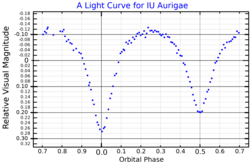| Observation data Epoch J2000 Equinox J2000 | |
|---|---|
| Constellation | Auriga |
| Right ascension | 05h 27m 52.40539s [2] |
| Declination | +34° 46′ 58.3435″ [2] |
| Apparent magnitude (V) | 8.19 to 8.83 [3] |
| Characteristics | |
| Spectral type | B0p + B1Vp [3] + ? |
| U−B color index | -0.66 |
| B−V color index | 0.18 |
| Variable type | Eclipsing binary [4] |
| Astrometry | |
| Radial velocity (Rv) | 9 ± 5 km/s |
| Proper motion (μ) |
RA: −4.479
[2]
mas/
yr Dec.: -9.049 [2] mas/ yr |
| Parallax (π) | 0.4786 ± 0.5765 mas [2] |
| Other designations | |
| Database references | |
| SIMBAD | data |
IU Aurigae is a triple star [6] system in the constellation Auriga, consisting of an eclipsing binary pair orbiting a third component with a period of 335 years. [7] This system is too faint to be viewed with the naked eye, having a peak apparent visual magnitude of 8.19. [3] The eclipsing pair form a Beta Lyrae-type semidetached binary of two Bp stars [3] with a period of 1.81147435 days. [4] During the primary eclipse, the visual magnitude of the system drops to 8.89, while for the secondary it decreases to 8.74. [3] [8] The third component is a massive object with 17–18 M☉, and may actually be a binary – which would make this a quadruple star system. [7]
References
- ^ Özdemir, S.; Mayer, P.; Drechsel, H.; Demircan, O.; Ak, H. (May 2003). "Refinement of third body parameters and new photometric results for the early-type multiple system IU Aurigae". Astronomy & Astrophysics. 403 (2): 675–681. Bibcode: 2003A&A...403..675O. doi: 10.1051/0004-6361:20030392.
- ^ a b c d e Brown, A. G. A.; et al. (Gaia collaboration) (August 2018). "Gaia Data Release 2: Summary of the contents and survey properties". Astronomy & Astrophysics. 616. A1. arXiv: 1804.09365. Bibcode: 2018A&A...616A...1G. doi: 10.1051/0004-6361/201833051. Gaia DR2 record for this source at VizieR.
- ^ a b c d e Avvakumova, E. A.; et al. (October 2013), "Eclipsing variables: Catalogue and classification", Astronomische Nachrichten, 334 (8): 860, Bibcode: 2013AN....334..860A, doi: 10.1002/asna.201311942, hdl: 10995/27061
- ^ a b Samus, N. N.; et al. (2017), "General Catalogue of Variable Stars", Astronomy Reports, 5.1, 61 (1): 80–88, Bibcode: 2017ARep...61...80S, doi: 10.1134/S1063772917010085, S2CID 125853869.
- ^ "IU Aur". SIMBAD. Centre de données astronomiques de Strasbourg. Retrieved 2019-08-18.
- ^ Mayer, P.; Drechsel, H. (September 1987), "Up-to-date parameters of the eclipsing triple system IU AUR", Astronomy and Astrophysics, 183 (1): 61–65, Bibcode: 1987A&A...183...61M.
- ^ a b Drechsel, H.; Haas, S.; Lorenz, R.; Mayer, P. (April 1994), "New photometric and spectroscopic results for IU Aurigae -- an early-type eclipsing binary in a multiple system", Astronomy and Astrophysics, 284 (3): 853–864, Bibcode: 1994A&A...284..853D.
- ^ Watson, Christopher (January 4, 2010), "IU Aurigae", The International Variable Star Index, American Association of Variable Star Observers, retrieved 2019-08-18.
